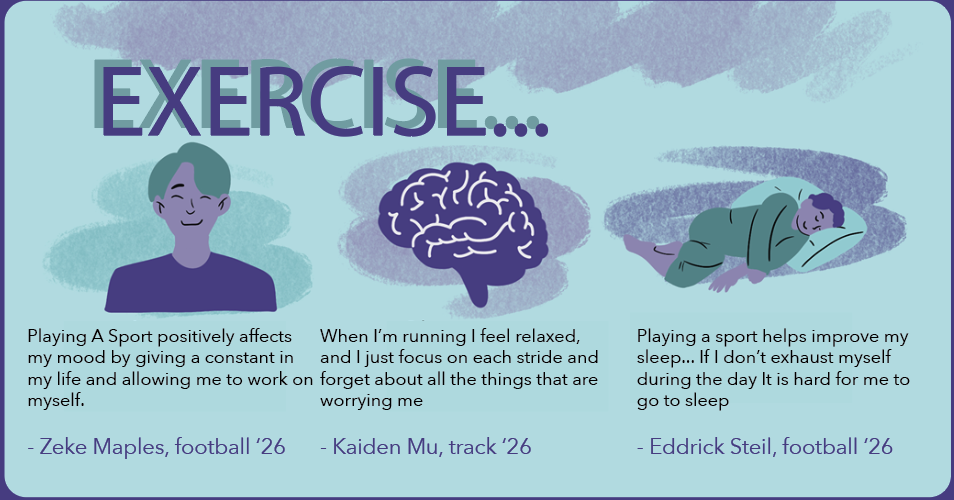High schoolers are no strangers to being stressed, anxious, depressed or lonely, and each kid has a different way of dealing with these negative emotions, some good, and some bad. From dangerous extremes like experimenting with addictive drugs to healthier strategies like participating in after-school activities, to using prescription medication or therapy, every high schooler has a go-to method of stress relief.
Among these strategies, one that is often tried and true for high schoolers is working out. Exercise has been proven to be one of the most positive strategies according to psychology. Participating in aerobic exercise naturally produces endorphins (or feel-good chemicals), improves focus afterwards, and science shows that gaining lean muscle mass can even help filter out toxins that cause depression. Exercising with friends or playing on a sports team can also provide a positive social community and working out can improve sleep, another important factor in reducing stress.
A national survey of 1.2 million Americans who were located through different sociodemographic and physical backgrounds, discovered that those who exercise experienced 1.49 (or 43.5%) fewer days of poor mental health or in the past month compared to those who did not exercise.
The data and science says it all: exercise improves mental health.
According to a Verde article in 2022, 60.6% of Paly students have participated in school sports.
While sports form an integral part of school life and culture, Paly and other local schools are somewhat unique in the competitiveness associated with academics. The cutthroat culture of Silicon Valley is brought to Paly culture from students’ upbringings. As the center of the tech industry, Palo Alto attracts the best and brightest entrepreneurs, engineers, businessmen, and other workers.
Yet the competitiveness of these people and jobs create an emphasis on students to be the best and succeed in school, graduate from a top university, and land a cushy job. While this competitiveness is not necessarily bad, it can also create pressure that leads to mental health issues for students.
Paly students pursue difficult course-loads because of the competitiveness and desire to do well in school, leading to stress and anxiety. Yet sports provide an opportunity to distract from that stress, as well as expunge it through physical activity.
Sophomore lacrosse player Shalin Dwivedi feels that playing on his team improves his entire school day by providing an outlet.
“I feel like playing a sport positively affects my mental health because after a long day of sitting and not doing much at school, it’s fun to get outside and have some fun,” Dwivedi said.
Overall, sports serve as a long-term method to achieve better physical health, which is closely related to mental health. In a joint study between Seoul National University and Columbia University, mental health was plotted with respect to hours of physical activity. The study analyzed data from 7674 adult respondents from a 2008 survey of American adults. The study found that the optimal amount of physical activity to maximize positive mental health was 2.5 to 7.5 hours of exercise a week. While the optimal exercise time depends on age, gender and physical health, the study found that those who engaged in the optimal exercise time reported a healthier mental state. At the same time, sports inhibit distractions from the stresses of being a student.
Sophomore baseball player Ian Johnston feels that playing his sport allows him to distance himself from school stress.
“Playing baseball positively affects my mental health by taking my mind off of school, and is just a place where I don’t have to think about any of my stress,” Johnston said.
Working out can be taken to an extreme, where exercise becomes a detriment to the mental health of the participant. According to Medline, a government medical information site, some people’s love of exercise can turn into a compulsion for exercise if one feels guilty for not working out, works out even if sick or injured, or, for girls, you lose a healthy period pattern.
One Paly student who wishes to remain anonymous recalls how their love of exercise became a compulsion to them.
“I just lost my passion for it,” they said. “I was turning down hanging out with friends because I still had to go to the gym that day and I was basically always sore since I didn’t give myself recovery time.”
Over-exercising can also be tied to dangerous eating disorders, and can even be caused by exercising, as the anonymous student noted.
“I was so concerned about getting the right nutrition in order to maximize my gains in the gym that it got to a point where I wasn’t eating normally,” they said.
However, this source was able to recover their love of working out after re-evaluating their priorities.
“I realized that I wasn’t having fun in the gym anymore or enjoying spending time with my gym buddies, so I basically took a week off and tried other workouts like hiking, which was a lot more fun for me,” they said. “Right now I have been doing more hikes with my buddies and I really have been enjoying working out again, which is great.”
As is commonly said, the dose makes the poison. Using exercise as a stress reliever can be positive and fun, but taking it too far can have the opposite effect. On that note, too much exercise is correlated with body dysmorphia, often leading to poor mental health.
To keep exercise as a fun and healthy activity, moderation is key; make sure you’re enjoying your time with friends and feeling energized after your workouts. The incredible health benefits of exercise are something that all students should experience, so if you are ever feeling down, try going for a walk or trying some exercises in the Paly gym during PRIME.





